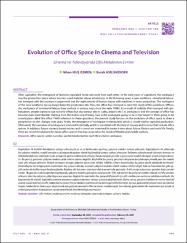| dc.contributor.author | Mus Ozmen, Nihan | |
| dc.contributor.author | Asiliskender, Burak | |
| dc.date.accessioned | 2021-11-27T07:44:40Z | |
| dc.date.available | 2021-11-27T07:44:40Z | |
| dc.date.issued | 2021 | en_US |
| dc.identifier.issn | 1309-6915 | |
| dc.identifier.uri | https //doi.org/10.14744/MEGARON.2021.70431 | |
| dc.identifier.uri | https://hdl.handle.net/20.500.12573/1038 | |
| dc.description.abstract | After capitalism, the emergence of factories separated home and work from each other. In the early years of capitalism, the workspace was the production space where business used material labour extensively. In the following years, a new workforce-immaterial labour-has emerged with the increase in paperwork and the replacement of human labour with machines in mass production. The workspace of this new workforce has no longer been the production site. Thus, the office has emerged to meet the needs of this workforce. Offices, the workspace of immaterial labour, have evolved in various ways since the early 1900s. As a result of mobility that emerged with globalization, people started to use not only offices but also various places (cafes, airports etc.) as workspaces and the concept of office has become even more flexible. Starting from the mobile era of today, how is the workspace going to be in the future? Is there going to be a workspace called 'the office'? With reference to these questions, the present study focuses on the evolution of office space to draw a perspective on the changes over years. Firstly, the emergence of workspace is mentioned, which is closely tied to capitalist production. Afterwards, the evolution of workspace is analysed historically, and it is visualized with the help of movies and tv series that include office spaces. In addition, future scenario based movies and tv series are examined to create a view about future lifestyle and work life. Finally, there are recommendations for future office spaces that may respond to the needs of flexible and mobile workers. | en_US |
| dc.language.iso | eng | en_US |
| dc.publisher | YILDIZ TECHNICAL UNIV, FAC ARCHITECTUREMerkez Yerlesim, Besiktas, istanbul, 34349, TURKEY | en_US |
| dc.relation.isversionof | 10.14744/MEGARON.2021.70431 | en_US |
| dc.rights | info:eu-repo/semantics/openAccess | en_US |
| dc.subject | workspace | en_US |
| dc.subject | work-life in cinema | en_US |
| dc.subject | spatial transformation | en_US |
| dc.subject | spatial evolution | en_US |
| dc.subject | Office spaces | en_US |
| dc.title | Evolution of Office Space in Cinema and Television | en_US |
| dc.type | article | en_US |
| dc.contributor.department | AGÜ, Mimarlık Fakültesi, Mimarlık Bölümü | en_US |
| dc.contributor.authorID | 0000-0002-4143-4214 | en_US |
| dc.contributor.authorID | 0000-0002-6137-882X | en_US |
| dc.contributor.institutionauthor | Mus Ozmen, Nihan | |
| dc.contributor.institutionauthor | | |
| dc.identifier.volume | Volume 16 Issue 2 Page 169-182 | en_US |
| dc.relation.journal | MEGARON | en_US |
| dc.relation.publicationcategory | Makale - Uluslararası - Editör Denetimli Dergi | en_US |


















